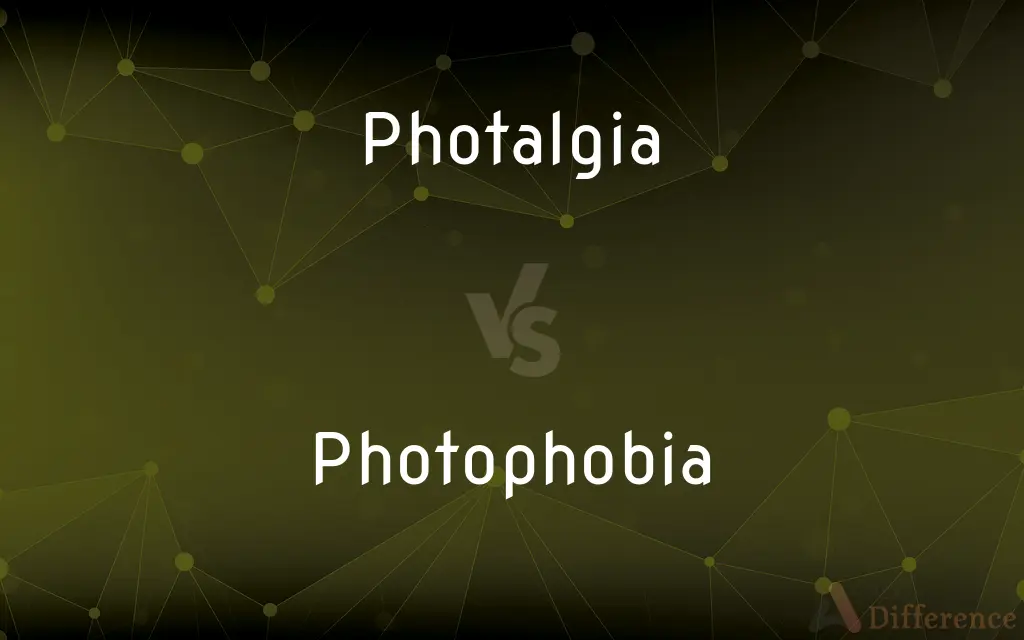Photalgia vs. Photophobia — What's the Difference?
By Urooj Arif & Maham Liaqat — Updated on May 7, 2024
Photalgia refers to pain in the eye caused by light exposure, focusing on discomfort; photophobia is a sensitivity to light where even normal levels can be intolerable, often indicating a broader issue.

Difference Between Photalgia and Photophobia
Table of Contents
ADVERTISEMENT
Key Differences
Photalgia is characterized by a painful response in the eyes resulting directly from exposure to light. This can occur due to conditions like corneal abrasion or inflammation within the eye. In contrast, photophobia involves an aversion to light due to its perceived intensity or brightness, which can cause discomfort or pain even at normal light levels.
While photalgia typically denotes a direct pain trigger from light exposure, impacting individuals particularly during the exposure, photophobia represents a more generalized sensitivity, making even moderate indoor lighting uncomfortable or intolerable. This condition is often associated with broader neurological or ophthalmological issues.
Individuals with photalgia experience sharp, often acute pain that is clearly linked to light exposure. This differs from photophobia, where the discomfort may persist as a dull ache or a severe reaction to light, affecting an individual's ability to be in well-lit environments.
Photalgia is often managed by treating the underlying eye condition and protecting the eyes from harsh light. On the other hand, managing photophobia may involve a wider range of strategies, including tinted glasses to reduce light intensity, medication to address underlying causes, and even behavioral strategies to gradually decrease light sensitivity.
Photalgia often involves a physical indication of damage or irritation in the eye, such as redness or swelling. Photophobia, while it may accompany visible symptoms like squinting or eye closure, is often more related to how light is perceived by the brain, indicating a more complex neurological interplay.
ADVERTISEMENT
Comparison Chart
Definition
Eye pain directly caused by light
Sensitivity to light, causing discomfort
Symptoms
Sharp pain, localized discomfort
General discomfort, avoidance of light
Associated Conditions
Corneal abrasion, uveitis
Migraine, brain injury
Management
Treating underlying condition, eye protection
Light reduction, medication
Perception
Direct pain response
Increased light perception sensitivity
Compare with Definitions
Photalgia
Associated with eye damage.
Photalgia in her right eye was due to a recent corneal scratch.
Photophobia
Can affect daily activities.
Due to photophobia, she avoids going outside during the day.
Photalgia
Pain triggered by light exposure.
After the eye surgery, he experienced photalgia when exposed to sunlight.
Photophobia
General light sensitivity.
Her photophobia makes it difficult to work in brightly lit offices.
Photalgia
Managed by protective measures.
Wearing sunglasses helps manage his photalgia effectively.
Photophobia
Often linked to other conditions.
Photophobia is a common symptom of severe migraines.
Photalgia
Indicative of eye health issues.
Persistent photalgia may suggest the need for a thorough eye examination.
Photophobia
Managed through environmental adaptations.
He uses tinted glasses to alleviate his photophobia.
Photalgia
Specific and localized.
Photalgia can be a specific response to ultraviolet light exposure.
Photophobia
Neurological basis.
Photophobia can stem from how the brain processes light signals.
Photalgia
Eye pain caused by bright light
Photophobia
Photophobia is a medical symptom of abnormal intolerance to visual perception of light. As a medical symptom photophobia is not a morbid fear or phobia, but an experience of discomfort or pain to the eyes due to light exposure or by presence of actual physical sensitivity of the eyes, though the term is sometimes additionally applied to abnormal or irrational fear of light such as heliophobia.
Photalgia
Pain in the eye resulting from exposure to bright light (often associated with albinism)
Photophobia
An abnormal sensitivity to or intolerance of light, especially by the eyes, as may be caused by eye inflammation, lack of pigmentation in the iris, or various diseases.
Photophobia
Fear of light.
Photophobia
(medicine) Excessive sensitivity to light and the aversion to bright light; abnormal fear of light.
Photophobia
An aversion to or fear of being photographed, the dissemination of personal photographs, or viewing photographs.
Photophobia
A dread or intolerance of light.
Photophobia
A morbid fear of light
Photophobia
Pain in the eye resulting from exposure to bright light (often associated with albinism)
Common Curiosities
Are there preventive measures for photophobia?
Preventive strategies might include using sunglasses or tinted lenses, adjusting indoor lighting, and treating any underlying medical conditions.
How do you treat photalgia?
Treatment involves addressing the underlying eye condition and protecting the eyes from further irritation by light.
Can photophobia be a symptom of other health issues?
Yes, it can be associated with conditions like migraine, brain injuries, and certain infections.
Can children have photophobia?
Yes, children can experience photophobia, especially if they have conditions like congenital brain anomalies or eye issues.
Is photalgia a common condition?
It can occur commonly in individuals with certain eye conditions or injuries.
What causes photalgia?
Photalgia is usually caused by specific eye conditions like abrasions or infections that make light exposure painful.
What types of light are most likely to cause photalgia?
Bright sunlight or artificial lights like fluorescents that emit high-intensity light can trigger photalgia.
How is photophobia different from being sensitive to bright lights?
While both involve discomfort from light, photophobia can be debilitating and is often linked to neurological or systemic issues, unlike simple light sensitivity.
How does one diagnose photophobia?
Diagnosis typically involves a medical evaluation, including a detailed history and examination by a healthcare provider.
Can lifestyle changes help manage photophobia?
Yes, lifestyle adjustments such as reducing screen time, wearing protective eyewear, and controlling light environments can help manage symptoms.
Share Your Discovery

Previous Comparison
Beautiness vs. Beauty
Next Comparison
Enriching vs. FulfillingAuthor Spotlight
Written by
Urooj ArifUrooj is a skilled content writer at Ask Difference, known for her exceptional ability to simplify complex topics into engaging and informative content. With a passion for research and a flair for clear, concise writing, she consistently delivers articles that resonate with our diverse audience.
Co-written by
Maham Liaqat















































